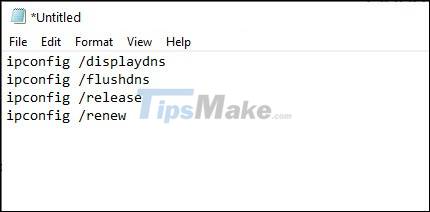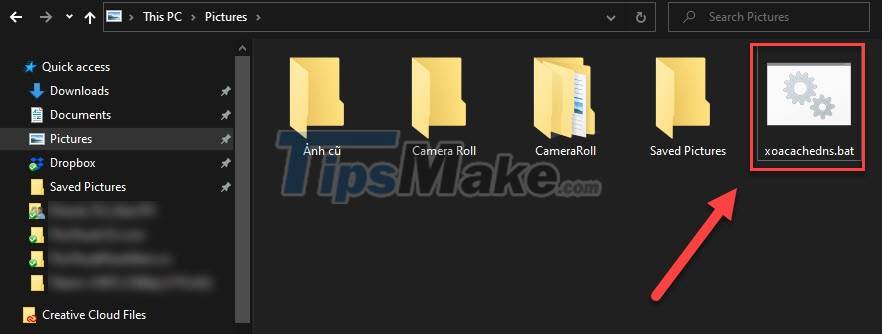How to run multiple commands at once in CMD
Run multiple commands at once using a .Bat . file
Usually, there will be situations where you need to run multiple commands like the following:
- Run multiple commands at the same time
- Run multiple commands one at a time
- Run subsequent commands only if the first command was executed successfully
- Run subsequent commands only if the first file fails to execute
With the method of running commands using a .Bat file, we will solve the case of 'running multiple commands at the same time'. For the next cases, please scroll down to the bottom of the article.
Step 1: Use the search box to find and open the Notepad application.

Step 2: Enter all the commands in the Notepad file that you want to execute at once. For this task, I want to clear the DNS cache, then refresh it. Normally would have to enter 4 commands in CMD, but now I add all commands in one file.
Commands include:
- ipconfig /displaydns
- ipconfig /flushdns
- ipconfig /release
- ipconfig /renew

Step 3: Press Ctrl + S to proceed to save the file. In the save window, choose an easy-to-remember name for the file and set the extension .bat.
Click Save when ready.

Step 4: Now go to the location where you saved the file, double click on it to launch it.

The commands will automatically be run in CMD and all you have to do is wait for the results.

Run multiple commands using &, &&, || . symbols
This way, you will run many commands in CMD with the remaining 3 cases mentioned above:
- Run multiple commands one at a time
- Run subsequent commands only if the first command was executed successfully
- Run subsequent commands only if the first file fails to execute
Symbol &
The first way is to use '&' in between the commands that you want to run. This will allow commands to be run sequentially.
Example: ipconfig /displaydns & ipconfig /flushdns & ipconfig /release & ipconfig /renew

Symbol &&
In this case, you add '&&' in between the commands: the second command runs only as long as the first one succeeds.
Example: ipconfig /displaydns && ipconfig /flushdns && ipconfig /release && ipconfig /renew

Symbol ||
The last method is easy to understand, you just need to add || in between commands, the 2nd command runs only when the first command executes failed.
Example: ipconfig /displaydns || ipconfig /flushdns || ipconfig /release || ipconfig /renew

Since the first command executed successfully, the chain of commands stopped right there. Alternatively, you can also combine symbols in the same command line: command1 & command2 && command3 || command4.
Conclusion
Very interesting isn't it? Hopefully these simple tricks will save you time in the process of running commands on CMD. Good luck!
You should read it
- How to open Command Prompt on Windows 10, 8, 7, Vista and XP
- How to Make Command Prompt Appear at School
- 6 Best Command Prompt Alternatives for Windows
- How to use Xcopy command in Command Prompt
- Instructions for using Command Prompt
- All Frequency Restart, Shutdown, Remote Off ... with Command Prompt
- Windows prompt
- How to Customize the Font in Windows Command Prompt
May be interested
- 15 Tar commands should try in Linux
 on * nix operating systems, such as linux, the commonly used utility is tar. the name of this command comes from archive tape, because it was originally designed to back up data on tape.
on * nix operating systems, such as linux, the commonly used utility is tar. the name of this command comes from archive tape, because it was originally designed to back up data on tape. - 12 Most Useful PowerShell Commands for Windows
 most it admins use powershell for scripting and automation, but it's not just for it pros—anyone who deals with messy folders needs these commands.
most it admins use powershell for scripting and automation, but it's not just for it pros—anyone who deals with messy folders needs these commands. - How to Run Linux Commands on Windows with WSL 2
 windows subsystem for linux 2 builds on the success of the original wsl, and the newer wsl 2 brings more power and reliability to users. it is important that you understand how to use linux commands and utilities on windows subsystem for linux 2.
windows subsystem for linux 2 builds on the success of the original wsl, and the newer wsl 2 brings more power and reliability to users. it is important that you understand how to use linux commands and utilities on windows subsystem for linux 2. - Combine all the most basic AutoCAD commands
 using autocad shortcut commands helps to manipulate faster. if you do not know all the cad commands, please see the summary of autocad commands that we have done below.
using autocad shortcut commands helps to manipulate faster. if you do not know all the cad commands, please see the summary of autocad commands that we have done below. - Top 10 examples of Netstat commands on Linux
 netstat is a command line utility that can be used to list all network connections (sockets), allowing comparison with network connections, routing tables, interface records, connection spoofing.
netstat is a command line utility that can be used to list all network connections (sockets), allowing comparison with network connections, routing tables, interface records, connection spoofing. - What is CMD Commands in Windows
 what is cmd commands in windows. for those who are new to computers, they will not know what cmd is and how to use it. so in the following article of tipsmake.com will help you answer what is cmd? and the most common commands used in cm
what is cmd commands in windows. for those who are new to computers, they will not know what cmd is and how to use it. so in the following article of tipsmake.com will help you answer what is cmd? and the most common commands used in cm - Use commands and some tips for Mac OS X
 in this tutorial we will show you how to use some commands and tips for mac os x.
in this tutorial we will show you how to use some commands and tips for mac os x. - 10 Netsh commands of Windows Server 2008 should know
 introducing 10 netsh commands that every administrator should know. netsh is very powerful and flexible, however, because it is not possible to select netsh 'most important' commands, since the importance of each command depends on administrative tasks in each specific task. so what we introduced in this article is 10 commands that we feel are valuable for you and help you when you encounter problems.
introducing 10 netsh commands that every administrator should know. netsh is very powerful and flexible, however, because it is not possible to select netsh 'most important' commands, since the importance of each command depends on administrative tasks in each specific task. so what we introduced in this article is 10 commands that we feel are valuable for you and help you when you encounter problems. - 10 commands to master when working with Cisco IOS
 if you want to master the cisco ios, you need to learn some necessary commands. the following article will summarize 10 useful commands to handle various troubleshooting and configuration tasks.
if you want to master the cisco ios, you need to learn some necessary commands. the following article will summarize 10 useful commands to handle various troubleshooting and configuration tasks. - PHP syntax
 before starting programming in any language, the basic syntax and program structure is very important. this chapter introduces you to the basic php syntax, including: php tags, comments, print commands, echo commands, and two print and echo commands.
before starting programming in any language, the basic syntax and program structure is very important. this chapter introduces you to the basic php syntax, including: php tags, comments, print commands, echo commands, and two print and echo commands.










 How to view your Chromebook's CPU information
How to view your Chromebook's CPU information How to compress and decompress files with PowerShell on Windows
How to compress and decompress files with PowerShell on Windows Fix Error not downloading or installing updates from Windows Update
Fix Error not downloading or installing updates from Windows Update Should Windows Defender be turned off?
Should Windows Defender be turned off? What is Hiberfil.sys? How to turn off Hibernate hibernation on Windows
What is Hiberfil.sys? How to turn off Hibernate hibernation on Windows Steps to check whether the Firewall on the computer is on or off
Steps to check whether the Firewall on the computer is on or off